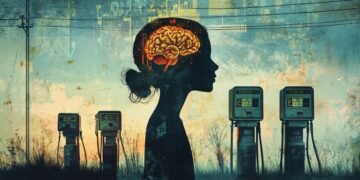Depression is a complex mental health disorder that impacts millions of people globally. More than a temporary feeling of sadness, it is a persistent condition that affects how a person thinks, feels, and functions daily. The symptoms of depression vary widely, but they often include profound sadness, low energy, difficulty in concentrating, changes in sleep and appetite, and a loss of interest in activities once enjoyed. Depression also has multiple types, each characterized by unique symptoms and treatment approaches.
1. Understanding Depression
Depression is formally defined as a mood disorder characterized by persistent sadness or loss of interest in nearly all activities, lasting for at least two weeks and significantly impairing daily functioning. While sadness is an element, depression is much deeper, affecting not just emotions but also cognitive processes, physical health, and behavior.
Depression is often categorized into several types, including Major Depressive Disorder (MDD), Persistent Depressive Disorder (PDD), Bipolar Disorder, Postpartum Depression, and Seasonal Affective Disorder (SAD). Each type has distinct symptoms and may respond differently to treatment approaches.
2. Types of Depression
1. Major Depressive Disorder (MDD): Also known as clinical depression, MDD is characterized by persistent low mood and lack of interest in most activities. Symptoms must be present for at least two weeks to receive a diagnosis. Individuals with MDD may feel empty, hopeless, and disconnected from the world around them.
2. Persistent Depressive Disorder (PDD): Also known as dysthymia, this type of depression is a chronic form that lasts for at least two years. People with PDD experience a persistent low mood that may not be as severe as MDD but is long-lasting and can make everyday life feel dull or challenging.
3. Bipolar Disorder: Previously referred to as manic-depressive illness, bipolar disorder involves extreme mood swings that include episodes of depression and mania. Depressive episodes are similar to MDD, while manic episodes may involve high energy levels, impulsive behaviors, and a reduced need for sleep.
4. Postpartum Depression: Affecting some women after childbirth, postpartum depression includes feelings of extreme sadness, anxiety, and exhaustion that interfere with a new mother’s ability to care for herself or her child.
5. Seasonal Affective Disorder (SAD): A type of depression related to changes in seasons, SAD often occurs during the winter months when daylight hours are shorter. This condition is thought to be linked to reduced sunlight exposure and may improve during sunnier months.
3. Symptoms of Depression
Depression manifests differently among individuals but commonly includes a range of emotional, behavioral, and physical symptoms.
• Emotional Symptoms: Persistent sadness, feelings of hopelessness, guilt, worthlessness, irritability, or frustration, and thoughts of death or suicide.
• Behavioral Symptoms: Withdrawal from friends and family, reduced participation in hobbies or enjoyable activities, neglecting responsibilities, and changes in sleeping and eating patterns.
• Physical Symptoms: Fatigue, changes in appetite and weight, unexplained aches or pains, and digestive problems.
The severity of these symptoms varies, with some people experiencing only mild symptoms and others facing severe impacts on their ability to function in daily life.

4. Causes of Depression
Depression has no single cause. Instead, it is thought to result from a combination of genetic, biological, environmental, and psychological factors.
• Genetics: Depression can run in families, suggesting a genetic component. People with a family history of depression may have a higher risk of developing the disorder.
• Brain Chemistry: Imbalances in neurotransmitters—such as serotonin, dopamine, and norepinephrine—are associated with mood regulation. These chemicals play a role in how the brain processes emotions and rewards.
• Hormonal Imbalances: Hormones can influence mood, particularly during periods of hormonal change, such as pregnancy, postpartum, and menopause, as well as thyroid issues.
• Environmental Factors: Traumatic events, chronic stress, and a lack of social support can increase the risk of depression. Childhood abuse, violence, or neglect can also contribute to the development of depression in later life.
• Psychological Factors: Individuals with low self-esteem, a pessimistic outlook, or tendencies toward perfectionism may be more susceptible to depression.
5. Impact of Depression on Life
Depression can affect every area of a person’s life. Social relationships, work performance, physical health, and overall quality of life are often impacted. Depression can lead to social isolation, as individuals may withdraw from friends and family due to a lack of interest or energy.
Depression also has a significant impact on work or academic performance, as symptoms like fatigue, difficulty concentrating, and reduced motivation can make tasks challenging. In severe cases, depression can lead to long-term unemployment or academic failure.
Moreover, depression is associated with various health conditions, including heart disease, obesity, and a weakened immune system. The emotional distress and potential for self-harm or suicidal ideation underscore the importance of addressing depression proactively.
6. Diagnosis of Depression
Diagnosing depression typically involves a combination of self-assessment, clinical evaluation, and screening tools. Healthcare providers use criteria from the Diagnostic and Statistical Manual of Mental Disorders (DSM-5) to determine if an individual meets the threshold for a depressive disorder.
• Clinical Interviews: These help doctors assess the severity and duration of symptoms and any potential causes. A history of symptoms, family background, and personal experiences are also considered.
• Screening Tools: Questionnaires, such as the Patient Health Questionnaire (PHQ-9), help quantify the severity of symptoms, providing a structured way to assess the impact on daily life.
• Physical Examination and Tests: Sometimes, a physical exam and blood tests are necessary to rule out other conditions, such as thyroid issues, which can mimic depression.
7. Treatment Options for Depression
Treating depression often involves a comprehensive approach, including medication, therapy, and lifestyle changes.
1. Medication: Antidepressants, such as selective serotonin reuptake inhibitors (SSRIs), serotonin-norepinephrine reuptake inhibitors (SNRIs), and atypical antidepressants, are commonly prescribed. These medications help balance brain chemicals associated with mood regulation.
2. Psychotherapy: Talk therapies, such as cognitive-behavioral therapy (CBT) and interpersonal therapy (IPT), have proven effective in treating depression. CBT helps individuals identify and change negative thought patterns, while IPT focuses on improving relationships and social functioning.
3. Lifestyle Changes: Regular exercise, a balanced diet, adequate sleep, and stress reduction techniques can have positive effects on mental health. Physical activity, in particular, has been shown to boost mood by releasing endorphins and improving energy levels.
4. Alternative Treatments: In cases where traditional methods are ineffective, electroconvulsive therapy (ECT) or transcranial magnetic stimulation (TMS) may be considered. These treatments involve stimulating certain areas of the brain to alleviate symptoms.
5. Support Systems: Support from family, friends, and support groups plays a critical role in recovery. Having a network of people who understand and empathize with one’s condition can provide emotional relief and encouragement.
8. Living with Depression
Managing depression is an ongoing process. Many individuals benefit from developing a daily routine that includes time for self-care, connecting with loved ones, and engaging in activities that bring joy.
Setting realistic goals and taking things one day at a time can prevent feelings of overwhelm. Practicing mindfulness or meditation can also provide a way to cope with depressive thoughts and focus on the present.
9. Breaking the Stigma Around Depression
Despite growing awareness, depression is still stigmatized. Misconceptions about depression often prevent individuals from seeking help. Educating the public about mental health and encouraging open conversations can help reduce this stigma. Recognizing depression as a medical condition, rather than a personal failing, is crucial for building empathy and promoting better mental health resources.
10. Prevention and Early Intervention
While not all cases of depression can be prevented, adopting healthy habits and seeking help at early signs can reduce severity. Awareness of mental health resources, regular exercise, balanced nutrition, and maintaining social connections all contribute to mental wellness.
Conclusion
Depression is a complex disorder that profoundly impacts millions of lives. It is crucial to recognize the symptoms, understand the causes, and explore treatment options to effectively manage and overcome depression. With support from healthcare providers, family, and community resources, individuals with depression can lead fulfilling lives. Education and open discussion about depression are essential steps in fostering empathy, improving resources, and reducing the stigma associated with mental illness.

























![[Cultivating Independence] The Rise of Domestic Lithium-Ion Battery Supply Chains in the U.S.](https://evergreenvitality.com/wp-content/uploads/2024/12/ev-battery-robots-factory-istock-1456466947-360x180.jpg)













![[Cultivating Independence] The Rise of Domestic Lithium-Ion Battery Supply Chains in the U.S.](https://evergreenvitality.com/wp-content/uploads/2024/12/ev-battery-robots-factory-istock-1456466947-120x86.jpg)


